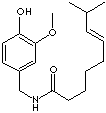PRODUCT IDENTIFICATION

H.S. CODE
TOXICITY
CLASSIFICATION
PHYSICAL AND CHEMICAL PROPERTIES
AUTOIGNITION
NFPA RATINGS
REFRACTIVE INDEX
Stable under ordinary conditions.
GENERAL DESCRIPTION & APPLICATIONS
Members of vanilloid include:
|
Product |
CAS RN |
|
N-Oleoyldopamine |
105955-11-1 |
|
Ruthenium Red |
11103-72-3 |
|
Arvanil |
128007-31-8 |
|
Capsazepine |
138977-28-3 |
|
Phorbol 12-phenylacetate 13-acetate 20-homovanillate |
175796-50-6 |
|
Dihydrocapsaicin |
19408-84-5 |
| (all Z)-N-(4-Hydroxyphenyl)-5,8,11,14-eicosatetraenamide | 198022-70-7 |
|
N-Arachidonoyldopamine |
199875-69-9 |
|
N-Vanillylnonanamide |
2444-46-4 |
|
(Z)-Capsaicin |
25775-90-0 |
|
1-(2-Hydroxyphenyl)-4-(3-nitrophenyl)-1,2,3,6-tetrahydropyrimidine-2-one |
36945-98-9 |
|
Isovelleral |
37841-91-1 |
|
(E)-Capsaicin |
404-86-4 |
|
Resiniferatoxin |
57444-62-9 |
|
Olvanil |
58493-49-5 |
|
Anandamide |
94421-68-8 |
|
Iodoresiniferatoxin |
n/a |
|
6-Iodonordihydrocapsaicin |
n/a |
|
4'-Chloro-3-methoxycinnamanilide |
n/a |
|
6'-Iodoresiniferatoxin |
n/a |
APPEARANCE
CAPSAICINOIDS
98.0% min
60 - 65 C
1.0% max
RESIDUE ON IGNITION
1.0% max
HEAVY METALS
20ppm max
HABANERO PEPPER
CAPSICUM CONTENT
11 - 13%
PARTICLE SIZE
40 mesh
FEMA No. 3404